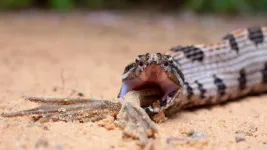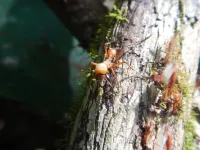(Press-News.org) New research published today in the Proceedings of the National Academy of Sciences (PNAS) shows that land use by human societies has reshaped ecology across most of Earth's land for at least 12,000 years. The research team, from over ten institutions around the world, revealed that the main cause of the current biodiversity crisis is not human destruction of uninhabited wildlands, but rather the appropriation, colonization, and intensified use of lands previously managed sustainably.
The new data overturn earlier reconstructions of global land use history, some of which indicated that most of Earth's land was uninhabited even as recently as 1500 CE. Further, this new PNAS study supports the argument that an essential way to end Earth's current biodiversity crisis is to empower the environmental stewardship of Indigenous peoples and local communities across the planet.
"Our work shows that most areas depicted as 'untouched,' 'wild,' and 'natural' are actually areas with long histories of human inhabitation and use," says UMBC's Erle Ellis, professor of geography and environmental systems and lead author. He notes that they might be interpreted like this because in these areas, "societies used their landscapes in ways that sustained most of their native biodiversity and even increased their biodiversity, productivity, and resilience."
Mapping 12,000 years of land use
The interdisciplinary research team includes geographers, archaeologists, anthropologists, ecologists, and conservation scientists. They represent the U.S., the Netherlands, China, Germany, Australia, and Argentina, pooling their knowledge and expertise into a large-scale study that required a highly collaborative approach. They tested the degree to which global patterns of land use and population over 12,000 years were associated statistically with contemporary global patterns of high biodiversity value within areas prioritized for conservation.
"Our global maps show that even 12,000 years ago, nearly three-quarters of terrestrial nature was inhabited, used, and shaped by people," says Ellis. "Areas untouched by people were almost as rare 12,000 years ago as they are today."
The maps created for the study are available to view interactively online:
[EMBARGOED LINK: https://anthroecology.org/anthromes/12kdggv1/maps/ge/]
The cultural practices of early land users did have some impact on extinctions. However, by and large, land use by Indigenous and traditional communities sustained the vast majority of Earth's biodiversity for millennia. This finding comes at a critical time of heightened need to develop long-term, sustainable answers to our biggest environmental problems.
"The problem is not human use per se," explains professor and co-author Nicole Boivin, of the Max Planck Institute for the Science of Human History in Jena, Germany. "The problem is the kind of land use we see in industrialized societies--characterized by unsustainable agricultural practices and unmitigated extraction and appropriation."
To truly understand terrestrial nature today, it is necessary to understand the deep human history of that nature. Outside of a few remote areas, "nature as we know it was shaped by human societies over thousands of years," says Ellis. He believes that efforts to conserve and restore "won't be successful without empowering the Indigenous, traditional, and local people who know their natures in ways that scientists are only beginning to understand."
Supporting Indigenous land use practices
The authors argue that their findings confirm that biodiversity conservation and restoration will benefit by shifting focus from preserving land in a form imagined as "untouched" to supporting traditional and Indigenous peoples whose land use practices have helped sustain biodiversity over the long term.
"This study confirms on a scale not previously understood that Indigenous peoples have managed and impacted ecosystems for thousands of years, primarily in positive ways," says Darren J. Ranco, associate professor of anthropology and coordinator of Native American research at the University of Maine. "These findings have particular salience for contemporary Indigenous rights and self-determination."
Ranco, a citizen of the Penobscot Indian Nation, notes that Indigenous people currently exercise some level of management of about 5% of the world's lands, upon which 80% of the world's biodiversity exists. Even so, Indigenous people have been excluded from management, access, and habitation of protected lands in places such as the U.S. National Parks.
"We must also assure that new attempts to protect lands and biodiversity are not just a green-grab of Indigenous lands," says Ranco. "We cannot re-create the worst of colonial policies meant to exclude Indigenous people, which would undoubtedly make the situation much worse for the environment and humanity."
A sustainable future
"Our research demonstrates the connections between people and nature that span thousands of years," says Torben Rick, study co-author and curator of North American Archaeology at the Smithsonian National Museum of Natural History. "These connections are essential for understanding how we arrived at the present and how to achieve a more sustainable future."
This research represents a new form of collaboration across archaeology, global change science, conservation, and scholars of Indigenous knowledge. The co-authors hope this work will open the door to increasing the use of global land use history data by natural scientists, policymakers, activists, and others. Leaders in a range of fields can use these data, they note, to better understand and collaborate with Indigenous, traditional, and local peoples to conserve biodiversity and ecosystems over the long term.
"It is clear that the perspectives of Indigenous and local peoples should be at the forefront of global negotiations to reduce biodiversity loss," says Rebecca Shaw, chief scientist at World Wildlife Fund and another study co-author. "There is a global crisis in the way traditionally-used land has been transformed by the scale and magnitude of intensive human development. We have to change course if we are to sustain humanity over the next 12,000 years."
INFORMATION:
Diversity in diet plays a role in the complexity of venom in pit vipers such as rattlesnakes, copperheads and cottonmouths.
But new collaborative research by Clemson University scientists found the number of prey species a snake ate did not drive venom complexity. Rather, it was how far apart the prey species were from each other evolutionarily.
"It's not just diet that drives the variation in venom across snakes. It's the breadth of diet," said Christopher Parkinson, a professor in the College of Science's Department of Biological Sciences. "If a snake eats 20 different species of mammals, its venom will not be very complex. But if it eats a centipede, a frog, a bird and a mammal, it's going to have a highly complex venom because each component of that venom ...
Antibiotics on the cocoon protect the offspring of beewolves, a group of digger wasps, from detrimental fungi. These protective substances are produced by symbiotic bacteria of the genus Streptomyces, which live in these insects. In a new study in PNAS, researchers from the Max Planck Institute for Chemical Ecology and the University of Mainz, together with an international team, showed that these beneficial bacteria are losing genetic material that is no longer needed. The genome of these bacteria is of great interest for understanding the process of genome erosion and elucidating how the cooperation and the mutual benefit between bacteria and their host insects have evolved over long periods of time (PNAS, doi: 10.1073/pnas.2023047118, ...
Police violence against Black Americans is shamefully common in the United States and devastates communities. For incidents that get widespread media exposure, a collective trauma is felt across the nation, especially for Black individuals. Research supports that experiencing racism even vicariously can harm the mental and physical health of others of the same racial group, yet its effect on a population level is unclear.
A new study analyzed how highly publicized acts of racial violence impacted the mental health of Black Americans in the U.S. The authors identified 49 incidents that occurred between 2013 and 2017, including police killings of Black individuals, hate-crime murders and decisions not to indict or convict the officers involved. The researchers measured ...
What keeps some plants squatting close to the soil while others - even those closely related - reach high for the skies?
New research addressing the architecture and growth habit of plants has provided an answer to this question and may assist in the development of better performing crops.
The way plants grow must sometimes satisfy contradictory needs. Growing close to the ground, decreases the chances of being grazed, but this presents the need to rise rapidly to allow seeds to disperse. This can be observed in dandelions and in Arabidopsis, a model species commonly used to study plant development.
Agriculture has taken advantage of the diversification of growth habit so that ...
Like superheroes capable of seeing through obstacles, environmental regulators may soon wield the power of all-seeing eyes that can identify violators anywhere at any time, according to a new Stanford University-led study. The paper, published the week of April 19 in Proceedings of the National Academy of Sciences (PNAS), demonstrates how artificial intelligence combined with satellite imagery can provide a low-cost, scalable method for locating and monitoring otherwise hard-to-regulate industries.
(WATCH VIDEO: https://www.youtube.com/watch?v=LHvRgKmJOK8)
"Brick kilns have proliferated across Bangladesh to supply the growing economy with construction materials, which makes it really hard for regulators to keep up with new kilns that are constructed," ...
A new type of collective behaviour in ants has been revealed by an international team of scientists, headed by biologist Professor Iain Couzin, co-director of the Cluster of Excellence "Centre for the Advanced Study of Collective Behaviour" at the University of Konstanz and director at the co-located Max Planck Institute of Animal Behavior, and Matthew Lutz, a postdoctoral researcher in Couzin's lab. Their research shows how ants use self-organized architectural structures called "scaffolds" to ensure traffic flow on sloped surfaces. Scaffold formation results from individual sensing and decision-making, ...
Researchers at Baylor College of Medicine and collaborators at other institutions have discovered that POT1, a gene known to be associated with risk of glioma, the most common type of malignant brain tumor, mediates its effects in a sex-specific manner. Researchers found that female mice with glioma that lacked the gene survived less than males. This led them to investigate human glioma cells, where they found that low POT1 expression correlated with reduced survival in females.
Published in the journal Cancer Research, the study also shows that, compared to males', female tumors had reduced expression of immune signatures and increased expression of cell replication markers, suggesting that the immune response and tumor cell proliferation seemed to be ...
Scientists at VCU Massey Cancer Center have identified a protein that operates in tandem with a specific genetic mutation to spur lung cancer growth and could serve as a therapeutic target to treat the disease.
Mutations in the p53 gene are found in more than half of all cancers, but it remains difficult to effectively target the gene with drugs even decades after its discovery. Though previous research has shown that p53 acts as a tumor suppressor and initiates cancer cell death in its natural state, a new study led by Sumitra Deb, Ph.D., suggests that gain-of-function (GOF) mutations -- a type of mutation where the changed gene has an added function ...
LOS ALAMOS, N.M., April 19, 2021--A new machine-learning program accurately identifies COVID-19-related conspiracy theories on social media and models how they evolved over time--a tool that could someday help public health officials combat misinformation online.
"A lot of machine-learning studies related to misinformation on social media focus on identifying different kinds of conspiracy theories," said Courtney Shelley, a postdoctoral researcher in the Information Systems and Modeling Group at Los Alamos National Laboratory and co-author of the study that was published last week in the Journal of ...
PHILADELPHIA-- A retrospective study led by researchers from Penn Medicine found that with MitraClip for treatment of secondary mitral regurgitation (MR), a heart disease associated with problems in the left ventricle, there was no negative effect of having a slightly smaller mitral valve opening as long as there was good reduction of the mitral regurgitation. The study is published today in JACC: Cardiovascular Interventions.
"This data is very reassuring for physicians who place MitraClips in patients with secondary mitral regurgitation. It demonstrates that the benefits of MR reduction in patients with heart failure were maintained even when mild-to-moderate mitral stenosis, which can be caused by a narrowing of the ...





